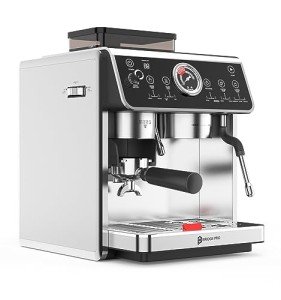The Rise of Home Espresso Machines: A Comprehensive Guide
As coffee lovers continue to seek fresh and tasty brews in your home, the appeal of home espresso machines has actually surged in the last few years. No longer simply the domain of cafes and coffeehouse, these machines empower people to craft barista-quality espresso beverages from the convenience of their kitchen areas. Discounted Espresso Machines will check out the different kinds of home espresso machines, their functions, and factors to consider for choosing the right one. Additionally, it will offer a choice of FAQs to assist potential purchasers make informed decisions.
Types of Home Espresso Machines
Home espresso machines can be classified into numerous categories based on their systems and user-friendliness. Each type has its distinct functions, pros, and cons.
| Type | Description | Pros | Cons |
|---|---|---|---|
| Manual Espresso Machines | Needs the user to by hand manage the brewing process, involving strategies like pulling a lever to produce pressure. | - Complete control over developing process - Compact style | - Requires skill and practice - Time-consuming |
| Semi-Automatic Machines | Machine automates water circulation and pressure, however the user still controls the dosing and period of the developing process. | - Balance of automation and control - Versatile | - Learning curve for improving strategies |
| Fully Automatic Machines | Automates the entire brewing procedure, from grinding to brewing, typically with programmable settings for tailored beverages. | - Extremely user-friendly - Quick and hassle-free | - Less control over the developing procedure - Higher cost point |
| Capsule or Pod Machines | Uses pre-packaged espresso capsules or pods to create coffee quickly and easily. | - Extremely easy to use - Minimal cleanup | - Limited flavor variety - More pricey per cup than ground coffee |
| Super-Automatic Machines | Integrates features of fully automatic machines with integrated grinders, allowing users to brew whole bean espresso and milk-based drinks with one touch. | - All-in-one benefit - Ideal for milk-based drinks | - Often the most costly - Can be large |
Features to Consider
When selecting a home espresso machine, prospective purchasers need to think about the following features to guarantee they select a machine that satisfies their needs:
Grinder Type:
- Built-in mills can offer fresher premises however may require more upkeep.
- Different grinders permit for more customization of grind size.
Pressure:
- Look for machines that produce at least nine bars of pressure, which is ideal for developing espresso.
Water Temperature Control:
- Machines with adjustable temperature level settings permit much better extraction of taste from beans.
Milk Frothing Options:
- Consider whether you desire a manual steam wand for frothing or an automatic milk frother for benefit.
Reduce of Cleaning:
- Machines with removable parts and self-cleaning functions substantially lower clean-up time.
Size and Design:
- Ensure the machine fits easily in your cooking area and lines up with your visual choices.
Budget:
- Set a budget before starting your search, as rates can range substantially from affordable models to high-end machines.
Benefits of Home Espresso Machines
Owning a home espresso machine provides numerous benefits:
- Cost-Effective: Over time, brewing espresso at home can conserve coffee enthusiasts cash compared to regular coffee shop sees.
- Customization: Users can try out various beans, grind sizes, and developing techniques to discover their best cup.
- Convenience: The ability to brew espresso whenever removes the need to go out to a café, particularly helpful throughout late nights or early mornings.
- Quality Control: With a home machine, individuals have total control over the quality of ingredients and brewing processes.
Downsides of Home Espresso Machines
Nevertheless, there are some drawbacks to think about:
- Initial Investment: High-quality espresso machines can be expensive, requiring a significant upfront financial investment.
- Knowing Curve: Mastering the art of espresso developing can take some time and practice, which might be intimidating for newbies.
- Upkeep: Like any home appliance, espresso machines require routine cleansing and maintenance to make sure optimal efficiency.
FAQs
1. What is Office Espresso Machines of home espresso machine for newbies?
Response: For novices, a semi-automatic machine is frequently recommended as it uses a balance in between control and automation, permitting you to find out the basics without overwhelming intricacy.
2. How much should I invest in a home espresso machine?
Answer: Entry-level machines can start around ₤ 100 to ₤ 300, while higher-end designs can vary from ₤ 500 to over ₤ 2000. It's vital to set a budget based on your anticipated use and desired features.
3. Do I need a separate grinder?
Response: While some espresso machines come with built-in mills, buying a different grinder enables greater personalization and guarantees much better quality premises.
4. How frequently should I clean my espresso machine?
Answer: Cleaning frequency can differ by machine type, however it's normally suggested to clean the machine after each use and carry out deep cleansings weekly or month-to-month, depending upon usage.
5. Can I make milk-based beverages with any espresso machine?
Answer: Not all machines feature milk frothing capabilities. If you delight in drinks like lattes or coffees, search for a machine with a steam wand or automatic frother.
Home espresso machines are transforming the way coffee aficionados enjoy their precious brews. With various types and advanced features available in the market, there is something for everyone. Whether it's the happiness of developing distinct recipes or merely enjoying the best shot of espresso, purchasing a home espresso machine can boost both the coffee-drinking experience and the lifestyle for coffee fans all over. As with any investment, it is crucial to weigh the benefits versus the possible disadvantages and pick a machine that effortlessly fits both your lifestyle and choices.

